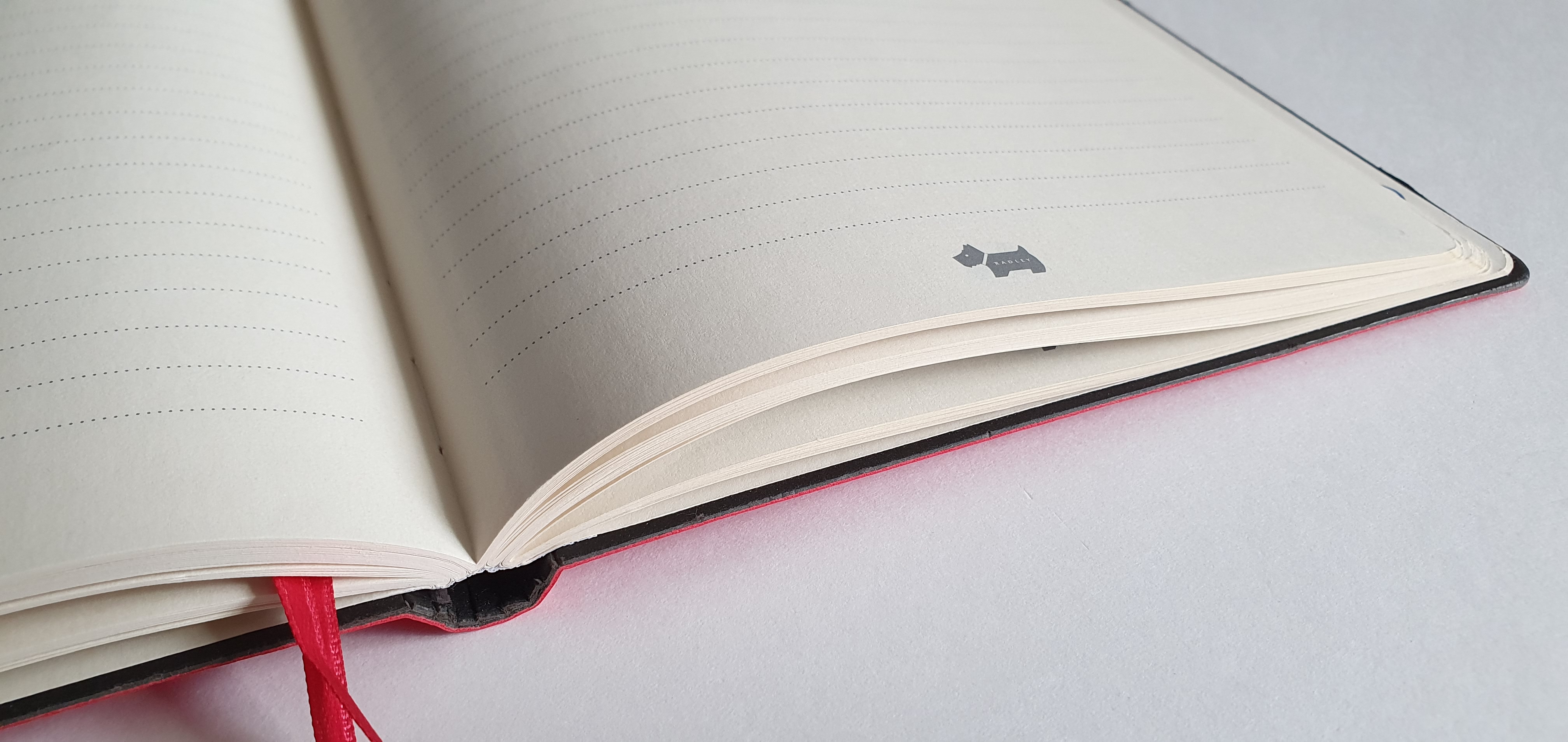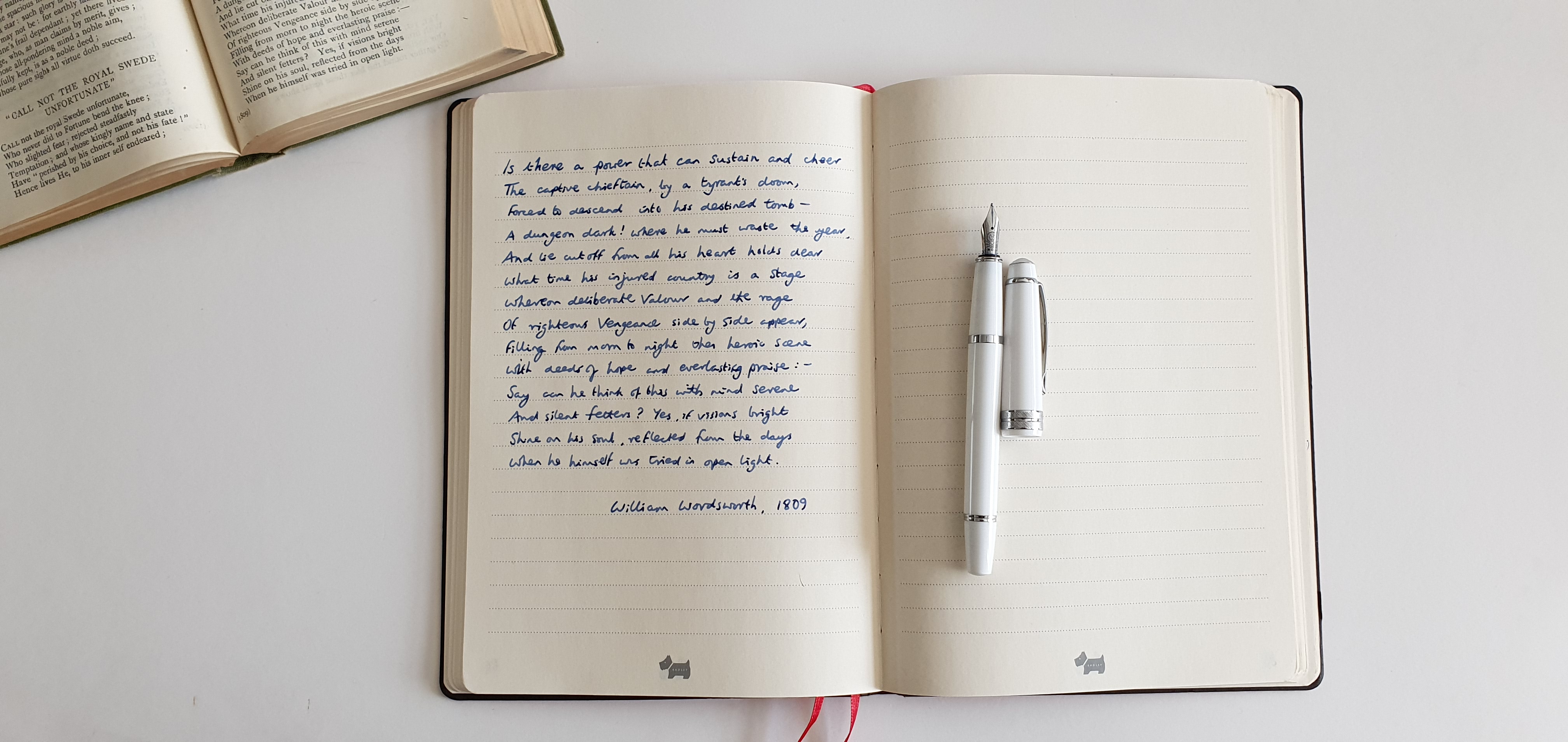As fountain pen users know, finding another dream combination of pen, ink and paper is one of life’s pleasures. And we could all use some of those now.
A month ago, whilst spending a weekend away in Cambridge my wife was browsing the sales in Radley, the handbag shop, when I came across a display of A5 notebooks. These were reduced from a rather ambitious £28.00, to £6.00 and so I cheerfully added a couple to our purchases.
It turned out that the notebook was remarkably good and I wished I had bought a few more to keep in stock. Many reading this post may not have access to a Radley shop, but nevertheless I hope some comments about my approach to notebooks may be of interest.
Description.
This is an A5, soft cover journal, with 160 ruled pages (80 sheets). The pages provide 21 rows at 8mm line spacing, which I find ideal. The lines are dotted, in grey, on a cream paper and so not obtrusive. Each page features the little Radley dog logo at the foot of the page, which is not in the way.

The cover is a vibrant red with rounded corners and a pleasing texture that feels like leather but is not. “Radley, London” is stamped elegantly in gold letters on the front. The cover can be flexed although it offers some support and protection. Of particular benefit, the pages are stitched, so that the book can be opened flat without risk of pages popping out. There are two page markers, in matching red ribbon. However there is no elastic band or expandable pocket that you would find with a Leuchtturm notebook.

Paper quality.
Trying a different notebook can be a risk, if you intend to use a fountain pen. Those first few strokes will tell you whether the paper is “fountain pen friendly” or not. Does the ink bleed through? Is there feathering? Is there show-through at levels which mean you can use only one side of the paper? How does the pen feel on the paper surface? Is it too rough, or too smooth, or is there a squeaky coating and feeling of resistance?
Happily, I was delighted with the paper in all of these respects. I tried first with my recently bought Platinum Curidas, with a Japanese medium nib and Platinum blue black ink. The paper surface felt silky smooth. There was no feathering, no bleed through and although some show-through, this was perfectly acceptable. The nib is on the fine side for a medium.
The one point to note however, was that the line width was slightly wider on the Radley paper, than with the same nib on my customary Leuchtturm journal paper. This implies that the paper is perhaps more absorbent, or less or differently coated than Leuchtturm. Yet when I looked with the loupe, there was no feathering to give the tell-tale woolly edges as if writing on blotting paper.

I do enjoy buying a new notebook. For the last few years I have been using Leuchtturm journals a lot, which are paginated and available with plain paper, ruled (rather too narrow for me) or dotted or square grid. For unpaginated notebooks, I often paginate them, measure the line spacing, and test out the paper on the back page with a variety of inks and pens from my “currently inked” pen cups to see what works and what does not.
I tried the Radley notebook paper with various other pen and ink combinations. There was no bleedthrough with Waterman Serenity blue. Monblack Irish Green did bleed through quite badly in places where pressure was applied. Some roller-ball pens also did not do so well: the Uniball Air micro black ink did bleed through, whereas the Uniball Signo 307 retractable gel pen did not.
Rohrer & Klingner, Salix iron gall blue black ink.
So, what was that dream team combination that I mentioned? I recently discovered Rohrer & Klingner’s Salix, an iron gall blue black ink, sold in London at Choosing Keeping, in Covent Garden. I have been using it at work recently, in one of my Cross Bailey Light cartridge pens. (Ahem, confession: I bought six of these pens, a few months ago as soon as I heard about them!)
The Cross Bailey Light is a fairly humble entry level Cross cartridge- converter fountain pen with a steel medium nib. I have been careful to check the nibs on all those I bought and they have all been smooth, wet writers. This works particularly nicely with Rohrer & Klingner’s Salix ink, a classic blue-black which darkens as it oxidises, as the blue turns to a grey-blue black.

The Salix ink is also water resistant, a useful quality when addressing envelopes but also giving some protection against spills or other liquid related incidents.
A water resistant ink will often perform well on papers which at first do not seem fountain pen friendly due to bleedthrough and so it is worth trying this before giving up on the notebook for fountain pen use. Another advantage of R&K Salix is that you can go over it with a highlighter pen, which is great for study notes. It also flows well, looks nice and gives a lovely shading and performs well on the Radley notebook paper.

Finally, I went back to the Cambridge Radley shop another day but they were out of these notebooks. But then I later came across another Radley store in London’s O2 Arena shopping centre (a brand outlet mall) where, not only did they have plenty in stock but they were discounted even further to £4.00. Let’s just say I bought a reasonable number.

Didn’t know they made notebooks too! If only they had stores in Canada ^_^;;
LikeLiked by 1 person
Thanks for reading! The fun/challenge is to identify which inks and pens work well with whatever paper you have. Your planner paper handles ink and water colours very well!
LikeLiked by 1 person
An interesting review – thank you. There’s always a sense of trepidation about trying new notebooks that have a hefty price tag attached to them, so when bargains like these present themselves, it’s just rude not to try one. I have a similar stash of the Rhodia Heritage notebooks. I found some at well below the going rate and bought up a decent number. I’m on a bit of a Tomoe River kick at the moment, but their time will come again.
LikeLiked by 1 person
Thankyou. Tomoe River spoils you for anything else but can be hard to find here. I mostly use the Leuchtturm A5 notebooks for general fountain pen writing.
LikeLiked by 1 person
That’s true to some extent, but it’s always good to have options. Part of the enjoyment is finding what works for you. How well the paper behaves is always a key factor, but I find with notebooks that the whole is definitely greater than the sum of its parts. Great paper in a poorly executed book can ruin the experience.
LikeLiked by 1 person